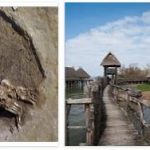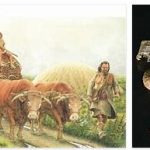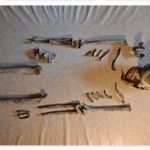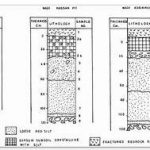Early phase of the Iron Age or Hallstatt (about 800-400 BC). – The civilization of the earliest Hallstatt period in southern Germany is the product of the merger of the primitive population – preserved eg. on the heights of the Swabian Alb – with the immigrant populations probably from the eastern regions of the urnfield civilization. This civilization represents a transitional phase, which also descends into the Hallstatt age: in connection with it we can distinguish, for western and southern Germany, two main periods of the Hallstatt civilization, one more ancient (800-600) and one most recent (600-400). The influx of new populations from the Illyrian area of the Eastern Alps, where iron also comes from, gives it its characteristic physiognomy. A commodity as important as iron now becomes salt, which is closely connected with the Hallstatt civilization. Typical of the earliest Hallstatt phase are the long iron sword and polychrome pottery in western and southern Germany. Here too an abundant material coming from the mounds, as well as from the houses and above all from the fortified castles on the heights, it attests that this first phase of the Hallstatt period had a relatively peaceful development. Towards 600, with the beginning of the migrations of the Celts and also as a consequence of the Germanic migrations caused by the worsening of the climate in the northern regions, a certain restlessness takes over. The custom of building castles spreads, and the dominance of a few individuals over the tribes is asserted. Indigenous production is increasingly giving way to imports from the south. Princely tombs of the century. VI and V, magnificently decorated, contain bronze vases from northern and central Italy and gold objects. The influence of the Hallstatt civilization extends as far as Silesia and central and north-western Germany; it manifests itself with the greatest intensity especially in the most recent phase of the Lusatian civilization. The two techniques, the old one, local, of cast bronze, and the new one, learned from the South, of beaten and laminated bronze, exist at the same time. The most important find made in the Germanic settlements is the golden treasure of Eberswalde, preserved in a clay vase of the Lusatian type; Schuchhardt wants to see in it the private treasure of a chief of the Germanic tribe of the Semnons.
Second phase of the Iron Age or La Tène (400 – beginning of the Common Era). – Already in the Hallstatt era, the Celts had the dominance from a cultural point of view. The appearance of the civilization of La Tène, typical of true and proper Celts, does not represent such a clear departure for North and East Germany as for South and West Germany. The first historical information on the Germanic peoples is now beginning to appear, first with the Greek historians, later with the Romans; Celtic-type names also begin to appear, such as. that of the Hacynia forest, which corresponds to the middle German mountainous area (Mittelgebirge), and many of those of rivers still in use today. The Greek name of Celts corresponds to the Roman name of Gauls. Thus we also come to know the name of individual Celtic tribes, such as the Elvezî, the Volci, the Boi, the Treveri and others who, after having settled in Germany coming from the West, invade western, southern and part of central Germany.. Based on the distinction between Gallic burial tombs and Germanic cremation tombs, the boundary line of the two races and its gradual displacement can be established, concluding that the Germanic population during the last centuries before the Common Era exercised a strong pressure on the regions of the South-West, which large parts of Germany were never occupied by the Celts, that finally in other areas the Celtic civilization in the broad sense had already suffered a sudden end in the Hallstatt period. The La Tène style is quite well known to us for numerous objects found in the tombs (at first in mounds, later in tombs dug into the ground or Flachgräber) and in homes; In this way it is possible for us to clearly determine their individual characteristics and to distinguish four phases, characterized by an increasingly pronounced barbarism, which however is accompanied by an ever more accentuated tendency towards simplification. Except for a few cases, this civilization of La Tene in Germany is nothing special compared to that of France. The style is the product of the mixture of the Ionic-classical style with a singular decorative style based on animals and certain ornamental motifs, such as the swollen spiral band; and it appears increasingly clear that the influences did not originate so much from the Mediterranean basin, but from Eastern Europe (with which Central Europe was in very close contact since the Neolithic age), especially from the Greek-Scythian manufacturing centers.. oppida of Caesar, and imitate prototypes of the southern regions; the others are small quadrangular entrenched systems, which in part reach the age of the wars against the Romans.
According to collegesanduniversitiesinusa.com, the further development of civilization in Germany, up to the fall of the Roman Empire (400 AD) belongs for the most part to history, no longer to prehistory. In unconquered Germany, indigenous civilization continues to develop on the basis of elements inherited from the La Tène civilization. But the Roman civilization that crosses the Danube and the Rhine is making itself felt more and more on the trade routes, as communications between Italy and the Danube become more frequent. Germanic tribes increasingly develop their own individuality: they are the Alamanni, the Franks, the Baiuvari, the Thuringians, the Lombards, the Vandals, the Goths. Innumerable necropolises, in which the dead are placed facing the East surrounded by weapons and ornaments, provide us with a idea of the height reached by the applied art of the ancient Germans; since, even taking into account all the influence exerted by the Roman art of the Late Empire, a considerable part of what remains was created by them by their own impulse, resorting to the treasure of the forms received from the North and the East. Throughout the period up to the Roman conquest, v.Germanic peoples.









